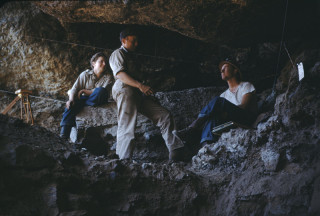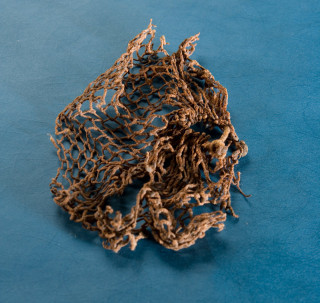Explorer Corps Marker: Tooele County
Find the Marker
The Tooele County marker is in the landscaped gravel on the southeast side of the Operations Building at Wendover Airport, right next to the Avfuel sign. It highlights Danger Cave, one of North America’s oldest archaeological sites.
GPS 40°43’39”N 114°2’15”W
Dig Deeper
Tooele County’s Danger Cave used to have a different name. Located not far from the Utah-Nevada border, this place used to be called “Hands and Knees Cave” because archaeologists curious about what might be inside had to get on their hands and knees to crawl in. That’s already a scary situation for the claustrophobic. But during excavations by the University of Utah in the middle of the 20th century, a boulder fell and almost crushed one of the archaeologists, a close call that inspired a new title – Danger Cave.

What brought the archaeologists to the cave in the first place was one of North America’s oldest archaeological sites. Located along the edge of the Bonneville Salt Flats, the cave contains signs of people using the cave as long as 12,000 years ago. Stone tools, baskets, ceramics, animal bones, plants, seeds, and hearths that hosted fires long ago have all been found in the cave. Archaeologists have been examining the site since 1940, going back over and over through the years to see what might be learned about some of the earliest people to inhabit the Americas.
Archaeologists’ thoughts on what the Danger Cave finds mean has changed over time. Following early excavations in the mid-20th century, archaeologists thought that the seeds and seed-processing artefacts found within the cave layers indicated that the people here had suited their lifestyle to unchanging desert environments. This was called the “Desert Culture concept.”
But later investigations of the cave and the clues found within indicated that this hypothesis wasn’t quite right. The oldest layers of the cave, between 12,000 and 9,700 years ago, didn’t show the blankets of seeds that the younger layers did. People were living in the cave, to be sure, but seed processing was a shift that happened later. The people who used and lived in Danger Cave during the earliest times were doing something different.
Exactly what that something different was, archaeologists and paleoecologists are still investigating. The 12,000 year mark is the end of the Ice Age, when the global climate became warmer and wetter. It was also when many large animals – such as mastodons and giant ground sloths – became extinct. That change might explain the shift seen in the Danger Cave layers.

The oldest layers of Danger Cave might represent a time when people were more reliant on big game, which would have been more abundant at the time. But as those animals began to become scarce, and then disappear, the people who lived in the area may have switched over to gathering seeds and plants – easier to get, even if they took more work to process and make edible. Then again, archaeologists have also hypothesized that the change might relate to gender roles, with some parts of the community going off to hunt while others stayed behind to process seeds.
All of these stories are connected. How the people who used Danger Cave lived, and how community habits changed through time, is tied to sweeping environmental changes that affected all of what’s now Utah. If we can understand a little more about what the layers of Danger Cave represent, we can understand a little more about just how dramatically these lands have changed through the ages.
Want to Go Farther?
Danger Cave is closed to public visitation to help protect the site. Visit the Natural History Museum of Utah’s archaeology exhibits to learn about Utah’s peoples and where they lived.